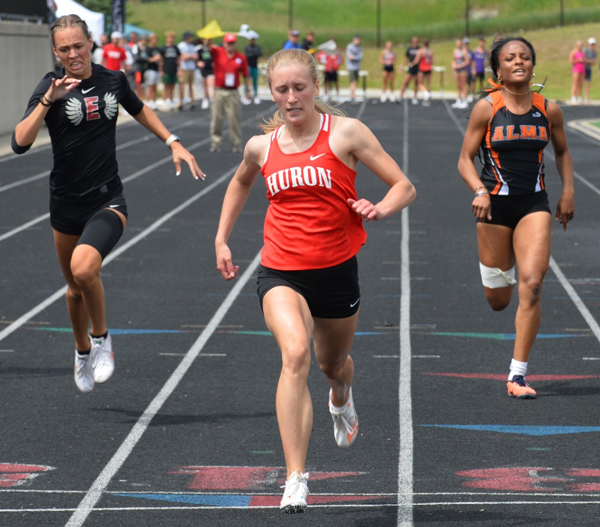
Blissfield's Smith Aims to Spring into More Long-Jumping Success
By
Doug Donnelly
Special for MHSAA.com
March 30, 2022
BLISSFIELD – The 2021 track & field season didn’t start the way Annabelle Smith had hoped, but it sure finished the way she wanted.
 Smith opened the season by long jumping only 15 feet, 5 inches, well short of her best. She bounced back quickly and never lost in the event again, culminating with a Lower Peninsula Division 3 championship in the event.
Smith opened the season by long jumping only 15 feet, 5 inches, well short of her best. She bounced back quickly and never lost in the event again, culminating with a Lower Peninsula Division 3 championship in the event.
“I think it was probably my worst day since middle school,” she said of last spring’s start.
Those days are long behind her. As she prepares for her senior season, she is confident, mentally strong, and physically ready to beat the early spring Michigan weather.
“It’s sort of hard for me because I much prefer warmer weather,” the Blissfield senior said. “Spring is my time to prepare. I try to give as much as I can.”
Michigan’s weather doesn’t do prep athletes any favors this time of the year. But, Smith said, it’s something you have to set aside and push through. It’s part of being mentally strong and focused.
“It’s something you can’t really control. You just have to deal with it.”
Smith picked up track & field in middle school. Her coaches had all of the athletes try every event to see what they were best at. She immediately took to the long jump. She qualified for the Finals as a freshman and tied for eighth place in the long jump but missed out on being named all-state due to a tiebreaker.
She trained hard for her sophomore year, only to have it canceled due to COVID-19. Last year she recovered from that early-season meet to win the Lenawee County championship, Lenawee County Athletic Association championship, Regional and Finals titles. She set a personal record at the LPD3 Finals meet with a jump of 18-1.5 and became Blissfield’s first female athlete to win a state track title in 30 years.
“What sets her apart is her competitiveness and ability to adapt in any situation,” said Calvin Sullins, a former decathlete at Siena Heights University who now coaches Smith at Blissfield. “She trusts our process and is an exceptional student of the sport.”
There was a time that Smith just went out, located her marks, and jumped.
 Sullins and the rest of the Royals coaching staff turned her head by concentrating on technique.
Sullins and the rest of the Royals coaching staff turned her head by concentrating on technique.
“Coach Sullins has a lot of knowledge about track in general,” she said. “It’s been great to work with him. Being a decathlete, he knows about every event.”
One of the techniques she learned was to count steps rather than just look for her mark when starting to sprint as she approaches the long jump platform.
“I use an 11-step approach,” she said. “I count 11 strides, and I lift off.”
She counts down in her head every time her left foot hits the ground.
“I jump when I’m at one,” she said. “I don’t have to worry where I’m at. It took a little bit to get used to, but it makes everything easier.”
She has scratched on occasion, but she trusts in her ability to take equal strides and count the 11 steps during her approach.
Being consistent in her events is her biggest challenge. She also takes pride in her mental approach to every event. There can be long breaks during a track meet, but she makes sure to get focused when she has to.
“Mentally, I’ve changed a lot,” she said. “For me, what works is to be very involved with the team and not spend my down time thinking about my event. When I start to warm up, I just envision what my jumps are going to look like. That’s my time to myself, my time to get focused.”
In between her junior and senior year of high school, she competed in a United States Track and Field Junior Olympic event in Atlanta, placing third in her division. She also had a national event in Florida. Closer to home, she entered some indoor meets in the open class in the area and trained whenever she found the opportunity to get out of the cold.
“I just tried to stay consistent all winter,” she said. “For me, technique is very important.”
Smith is looking at a few colleges, some nearby and some across the country. She’s undecided what she wants to do or where she wants to compete at the next level.
This year she intends to compete in the 100 or 200 meters and possibly some relays as well as the long jump. Her goal is to start stronger than last year and steadily improve as the season goes on and be at her best come the first weekend in June – when the MHSAA Finals take place.
“This year, my goal is to PR and get back to the state meet and place,” she said. “I have a lot of time to improve myself. That’s my main goal – to be better.”
 Doug Donnelly has served as a sports and news reporter and city editor over 25 years, writing for the Daily Chief-Union in Upper Sandusky, Ohio from 1992-1995, the Monroe Evening News from 1995-2012 and the Adrian Daily Telegram since 2013. He's also written a book on high school basketball in Monroe County and compiles record books for various schools in southeast Michigan. E-mail him at [email protected] with story ideas for Jackson, Washtenaw, Hillsdale, Lenawee and Monroe counties.
Doug Donnelly has served as a sports and news reporter and city editor over 25 years, writing for the Daily Chief-Union in Upper Sandusky, Ohio from 1992-1995, the Monroe Evening News from 1995-2012 and the Adrian Daily Telegram since 2013. He's also written a book on high school basketball in Monroe County and compiles record books for various schools in southeast Michigan. E-mail him at [email protected] with story ideas for Jackson, Washtenaw, Hillsdale, Lenawee and Monroe counties.
PHOTOS (Top) Annabelle Smith, right, and credits her Blissfield coach Calvin Sullins with helping her become a championship long jumper. (Middle) Smith jumps during the 2019 Lenawee County Championships. (Top photo courtesy of the Smith family; middle photo by Mike Dickie.)

Multi-Sprint Champ Racing to Finish Huron Career Ahead of the Rest Again
By
Keith Dunlap
Special for MHSAA.com
May 25, 2023
NEW BOSTON – If there was one thing Elizabeth Anderson took pride in elementary school, it was simply showing that she could outrun everyone in sight.
 In fact, Anderson has an explanation for all the success she had in those playground races.
In fact, Anderson has an explanation for all the success she had in those playground races.
“Dominance when you are in elementary school,” Anderson quipped. “I don’t think I ever had a nickname. I just think everyone knew I was fast.”
Years later, pretty much everyone who follows track & field in the state of Michigan can attest to that.
A senior for New Boston Huron, Anderson has been faster than most other competitors in the state during her three-year high school career (with her freshman season in 2020 canceled due to COVID-19).
Last year, Anderson won titles at the Lower Peninsula Division 2 Finals in the 200-meter (25.07) and 400-meter (56.28) dashes, and was runner-up in the 100-meter dash (12.23).
Often, top sprinters focus on one or two of those three races. But Anderson is certainly a different breed of sprinter because she does all three.
In fact, she holds school records in all three of those events, and if all that weren’t enough, Anderson is a part of all three sprint relay teams.
“It is hard to give her events off,” said New Boston Huron head girls track coach Danielle Lobato.
Despite the different styles the 100, 200 and 400-meter dashes present, Anderson said there usually isn’t much adjusting when she goes from one of those races to another.
 The strategy is simply, “Let’s beat the other girls to the finish line.”
The strategy is simply, “Let’s beat the other girls to the finish line.”
“I don’t really go into each race changing up how I would run,” she said.
While enjoying and succeeding in all three races, Anderson said she actually does have a favorite among them.
“I would say the 400 is probably my favorite,” she said. “Even though it hurts, it’s satisfying to see how much you can get your time down in the 400 compared to any other race.”
Anderson said she started running track in sixth grade, but really got serious about it during the summer after her sophomore season, when she was invited to run for a local club.
Eventually, that led to her competing over the winter in indoor events.
She lived and breathed track so much that last fall, she decided to not run cross country so she could focus on a weightlifting regimen aimed at developing more leg strength.
“Once I started doing summer track, I realized I wanted to be doing this all the time,” she said.
Lobato said oftentimes in practice, Anderson is a de facto coach, given there is no better person she can think of for the younger runners on the team to learn from.
“I can’t always demonstrate these things I’m trying to teach,” she said. “You get to see it in real life (from Anderson), not in a YouTube video.”
After winning the 100, 200 and 400-meter dashes at her Regional meet last week, Anderson has her sights set on achieving the same trifecta of titles at next Saturday’s Finals in Grand Rapids.
Anderson has signed to run track at Michigan State, but has been plenty motivated to keep producing this spring in her final high school season.
“I’m really looking to defend my titles,” she said. “That is what is really motivating me to keep going. I want to keep in shape for the college season. I don’t want to lose any of the progress I have made. Ultimately, I just love running track.”
And since elementary school, Anderson has loved — and succeeded in — outrunning everyone else to the finish line.
“We knew we were getting something special,” Lobato said of when Anderson arrived in high school. “But you never expect this. All that she has accomplished is amazing.”
 Keith Dunlap has served in Detroit-area sports media for more than two decades, including as a sportswriter at the Oakland Press from 2001-16 primarily covering high school sports but also college and professional teams. His bylines also have appeared in USA Today, the Washington Post, the Detroit Free Press, the Houston Chronicle and the Boston Globe. He served as the administrator for the Oakland Activities Association’s website from 2017-2020. Contact him at [email protected] with story ideas for Oakland, Macomb and Wayne counties
Keith Dunlap has served in Detroit-area sports media for more than two decades, including as a sportswriter at the Oakland Press from 2001-16 primarily covering high school sports but also college and professional teams. His bylines also have appeared in USA Today, the Washington Post, the Detroit Free Press, the Houston Chronicle and the Boston Globe. He served as the administrator for the Oakland Activities Association’s website from 2017-2020. Contact him at [email protected] with story ideas for Oakland, Macomb and Wayne counties
PHOTOS (Top) New Boston Huron's Elizabeth Anderson clears the finish line during last season's LPD2 400 race. (Middle) Anderson, middle, outpaces the field to also win the 200. (Click for more from RunMichigan.com.)

